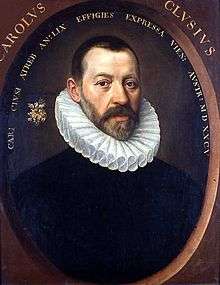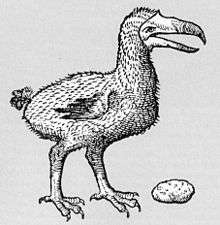Carolus Clusius


Charles de l'Écluse, L'Escluse, or Carolus Clusius (Arras, February 19, 1526 – Leiden, April 4, 1609), seigneur de Watènes, was a Flemish doctor and pioneering botanist, perhaps the most influential of all 16th-century scientific horticulturists.
Life
Clusius studied at Montpellier with the famous medical professor Guillaume Rondelet, though he never practiced medicine.[1] In 1573 he was appointed prefect of the imperial medical garden in Vienna by Maximilian II and made Gentleman of the Imperial Chamber, but he was discharged from the imperial court shortly after the accession of Rudolf II in 1576. After leaving Vienna in the late 1580s he established himself in Frankfurt am Main, before his appointment as professor at the University of Leiden in October 1593.
Work
Clusius helped create one of the earliest formal botanical gardens of Europe at Leiden, the Hortus Academicus, and his detailed planting lists have made it possible to recreate his garden near where it originally lay.
In the history of gardening he is remembered not only for his scholarship but also for his observations on tulips "breaking" — a phenomenon discovered in the late 19th century to be due to a virus — causing the many different flamed and feathered varieties, which led to the speculative tulip mania of the 1630s. Clusius laid the foundations of Dutch tulip breeding and the bulb industry today.
His first publication was a French translation of Rembert Dodoens's herbal, published in Antwerp in 1557 by van der Loë. His Antidotarium sive de exacta componendorum miscendorumque medicamentorum ratione ll. III ... nunc ex Ital. sermone Latini facti (1561) initiated his fruitful collaboration with the renowned Plantin printing press at Antwerp, which permitted him to issue late-breaking discoveries in natural history and to ornament his texts with elaborate engravings. Clusius, as he was known to his contemporaries, published two major original works: his Rariorum aliquot stirpium per Hispanias observatarum historia (1576)— is one of the earliest books on Spanish flora— and his Rariorum stirpium per Pannonias observatorum Historiae (1583) is the first book on Austrian and Hungarian alpine flora.[2][3] His collected works were published in two parts: Rariorum plantarum historia (1601) contains his Spanish and Austrian flora and adds more information about new plants as well as a pioneering mycological study on mushrooms from Central Europe; and Exoticorum libri decem (1605) is an important survey of exotic flora and fauna, both still often consulted. He contributed as well to Abraham Ortelius's map of Spain. Clusius translated several contemporary works in natural science.
Clusius was also among the first to study the flora of Austria, under the auspices of Emperor Maximilian II. He was the first botanist to climb the Ötscher and the Schneeberg in Lower Austria, which was also the first documented ascent of the latter. His illustrated works form an important chapter in sixteenth century natural history.[4]
Legacy
His contribution to the study of alpine plants has led to many of them being named in his honour, such as Gentiana clusii, Potentilla clusiana and Primula clusiana. The genus Clusia (whence the family Clusiaceae) also honours Clusius.
Publications

- 1557: Rembert Dodoens, Histoire des plantes: French translation from Dutch
- 1567: Garcia de Orta, Aromatum et simplicium aliquot medicamentorum apud Indios nascentium historia: Latin translation from Portuguese
- 1574: Nicolás Monardes, De simplicibus medicamentis ex occidentali India delatis quorum in medicina usus est: Latin translation from Spanish
- 1579: Revised edition under the title Simplicium medicamentorum ex novo orbe delatorum, quorum in medicina usus est, historia
- Clusius, Carolus (1576). Rariorum alioquot stirpium per Hispanias observatarum historia: libris duobus expressas. Antwerp: Christophori Plantinus.
- 1582: Compendium of the translations from Garcia de Orta and Nicolás Monardes, now combined with selections from Cristóbal Acosta, Tractado de las drogas y medicinas de las Indias orientales
- 1593: Further revised edition of this compendium
- 1583: Rariarum stirpium per Pannonias observatorum Historiae
- Clusius, Carolus (1601). Rariorum plantarum historia: quae accesserint, proxima pagina docebit. Antwerp: Ioannem Moretum.
- 1605: Exoticorum libri decem, including final revised editions of the translations from Garcia de Orta, Nicolás Monardes and Cristóvão da Costa
Translations of his work
- 1589: Dell'historia dei semplici aromati et altre cose che vengono portare dall'Indie Orientali pertinente all'uso della medicina ... di Don Garzia dall'Horto. Italian re-translation by Annibale Briganti of Clusius's edited translations of Garcia de Orta and Nicolás Monardes
- “Some notes of Charles L`ecluse a native of Gaul Upon the history of spices by Garcia de Orta’s Aromatum et Simplicium Historia”, Translated by Reverend Martin Pollard, O.S.B., Edited and Introduction by Garry D. Gitzen, Fort Nehalem Publishing, Wheeler, Oregon (2009)
- Clusius, Carolus. A treatise on tulips. Translated by W. van Dijk. Haarlem: Enschede, 1951. (Translation of a section from the Rariorum plantarum historia of 1601.)
References
- ↑ Egmond 2010.
- ↑ The illustrations in the Rariorum aliquot stirpium per Hispanias observatarum historia were based on drawings made by Clusius himself and the Flemish artist Pieter van der Borcht, which were cut by the engraver Gerard van Kampen. The originals of these drawings are collected in the Libri picturati A. 16-31 held by the Jagiellonian Library of the Jagiellonian University in Kraków (originally in the former Preussischer Staatsbibliothek of Berlin). (Spanish)
- ↑ Libri picturati A. 16-31 at the Jagiellonian Library of the Jagiellonian University in Kraków
- ↑ Schoepflin, Lefèvre & Renn 2003.
- ↑ IPNI. Clus.
Bibliography
- Egmond, Florike (2010). The World of Carolus Clusius: Natural History in the Making, 1550-1610. Pickering & Chatto. ISBN 9781317324218. Retrieved 5 October 2016.
- Lefèvre, Wolfgang; Renn, Jürgen; Schoepflin, Urs, eds. (2003). The Power of Images in Early Modern Science. Basel: Birkhäuser Basel. ISBN 9783034880992.
- Hunger, Friedrich Wilhelm Tobias. Charles de L’Escluse (Carolus Clusius) Nederlandsch kruidkundige, 1526–1609. 2 vols. The Hague: M. Nijhoff, 1927–43. (Text in Dutch and German, documents in Latin.)
- Ogilvie, Brian W. The Science of Describing: Natural History in Renaissance Europe. Chicago: University of Chicago Press, 2006. (Clusius receives extensive consideration.)
- Esther van Gelder: Tussen hof en keizerskroon. Carolus Clusius en de ontwikkeling van de botanie aan Midden-Europese hoven (1573–1593), Leiden: Leiden University Press, 2011. Fulltext
External links
| Wikimedia Commons has media related to Carolus Clusius. |
- Online edition (in-progress) of the complete correspondence of Carolus Clusius (1600 letters, 1000 transcriptions) at Huygens ING.
- Clusius Garden, Botanical Garden of Leiden University
- 1300 letters of Clusius online at Leiden University Library
- Clusius project online at Leiden University Library
- Rariorum plantarum historia at Botanicus
- Complete list of works